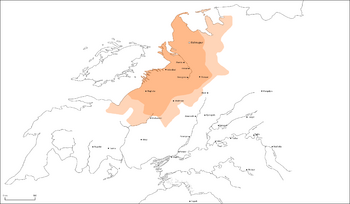Naratha Confederacy
This article is incomplete because it is pending further input from participants, or it is a work-in-progress by one author. Please comment on this article's talk page to share your input, comments and questions. Note: To contribute to this article, you may need to seek help from the author(s) of this page. |
Naratha Confederacy | |||||||||||||||||||||||||
|---|---|---|---|---|---|---|---|---|---|---|---|---|---|---|---|---|---|---|---|---|---|---|---|---|---|
| 1635–1847 | |||||||||||||||||||||||||
|
Military Banner (1635-1776) Confederate Flag (1776-1847) | |||||||||||||||||||||||||
 The Naratha Confederacy in 1784 | |||||||||||||||||||||||||
 The change of territory of the Naratha Confederacy | |||||||||||||||||||||||||
| Status | Confederation | ||||||||||||||||||||||||
| Capital | Bishnupur (from 1776) | ||||||||||||||||||||||||
| Common languages | Matrabashi | ||||||||||||||||||||||||
| Government | Confederal, elective monarchy | ||||||||||||||||||||||||
| Kulaadhipati | |||||||||||||||||||||||||
| Chhatrapati | |||||||||||||||||||||||||
| Legislature | Sanghasabha | ||||||||||||||||||||||||
| Historical era | Togoti Era | ||||||||||||||||||||||||
• Vichalan Accords | 1635 | ||||||||||||||||||||||||
• Treaty of Bishnupur | 1776 | ||||||||||||||||||||||||
• Southern Conquest | 1784 | ||||||||||||||||||||||||
• Great Betrayal | xxxx | ||||||||||||||||||||||||
• Etrurian Invasion | 1847 | ||||||||||||||||||||||||
| Currency | Multiple | ||||||||||||||||||||||||
| |||||||||||||||||||||||||
| Today part of | |||||||||||||||||||||||||
The Naratha Confederacy (Matrabashi: Naratha Sangharsh) was a multi-ethnic complex of polities in north-western Satria that developed during the Togoti Era and continued until its collapse in 1847. From its establishment in 1635 to its collapse, the Confederacy was dominated by three blocks – Sanyukt, Rathankot, Zulmat and the Lowlands – with the Sanyukti and Rathani blocks dominating the politics and leadership of the Confederacy. The core of the confederacy remained intact throughout its existence but its peripheral borders would change considerably throughout the lifespan of the Naratha Confederacy. The external borders of the Confederacy did not change considerably from the Treaty of Bishnupur – which saw the departure of the Lowlands, consolidation of power in the newly created position of Chhtrapati, and centralisation of the confederate government in the new confederate capital of Bishnupur – to the dissolution of the Confederacy.

